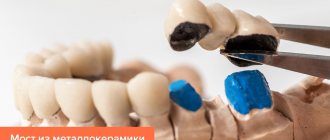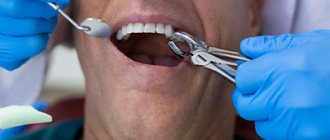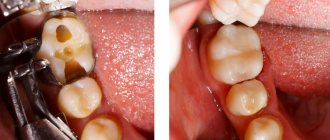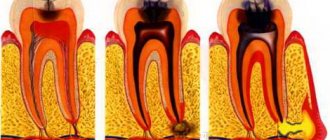In dental practice, there are often cases of advanced caries when a patient comes with complaints of acute toothache. If a doctor diagnoses pulpitis, then one of the stages of its treatment will be the installation of a temporary filling. It protects the canal from food and bacteria entering it. It should cover the exposed area of the tooth until treatment is completed by filling the canals and installing a permanent filling. In addition, the “temporary solution” is also relevant for a number of other pathologies.
Normally, the temporary “protection” is removed by the dentist. But there are situations when it falls out on its own. Why? Various factors can provoke this. But no matter what causes the temporary filling to fall out, it is important to know what to do in this situation and how to prevent complications from developing. After all, the consequences can be very unpleasant - from the spread of infection to the loss of a unit.
When is a temporary filling needed?
When a patient with caries comes to the dentist complaining of tooth pain, it is important for the doctor to assess how deeply the unit is affected and whether the roots and canals are affected. To do this, he sets up a “temporary station” for 2-3 days. If the nerve endings are damaged and a permanent filling is placed, the patient will again experience toothache and will have to have the tooth re-treated. A temporary filling will avoid unnecessary costs and stress.
The dentist decides to install temporary filling material if he diagnoses the patient with:
- deep caries;
- pulpitis;
- periodontitis;
- granuloma;
- tooth cyst;
- abscess.
Such dental manipulation is relevant if it is impossible to treat a tooth in one visit or you need to first relieve the inflammatory process. The doctor also places such a filling while the stump inlays or prostheses are being made in the laboratory.
Stock
-25%
Removable denture for 1 jaw 40,000 rub.
30,000 rub.
get -9 %
BASAL COMPLEX - Restoration of teeth on 1 jaw in 3 days 330,000 rub.
300,000 rub.
get -47 %
Dental implant Osstem 35,000 rub.
18500 rub.
get -20 %
Manufacturing of removable denture Acry Free 40,000 rub.
32,000 rub. get
How long is it temporary?
The period for installing such a filling depends on the purpose and clinical situation. It can range from 3 days to several months. If the doctor uses arsenic-based paste, then further treatment is carried out after 3-5 days, a maximum of a week. You cannot walk with arsenic in your tooth for any longer, as it can not only kill the nerve, but also destroy healthy tissue.
If the material used is necessary to protect against food and bacteria getting inside the canals during their sanitation or treatment of inflammation, it can remain in the tooth for several weeks. For longer treatments, the dentist may replace temporary fillings if a new dose of medication becomes necessary.
Are there any medications or other remedies
You should also not take any medications or drugs designed to speed up the emptying of food from the stomach. Extra irritants will not bring any benefit. You should also not try to get rid of a tooth with carbonated drinks. They will only further damage the teeth still left in your mouth. Take care of them so as not to encounter the problem indicated above again.
And most importantly, don’t panic. There is nothing wrong with swallowing a small foreign object as long as it does not have sharp edges and is not dangerous in itself. Your health will not be endangered if timely measures are taken and qualified assistance from a specialist.
Ingested temporary fillings containing arsenic must be neutralized
What causes a temporary filling to fall out?
A patient may have a temporary filling fall out due to medical negligence:
- if the doctor did not properly dry the tooth cavity after pre-treatment or saliva got there before applying the filling material;
- if, after cleaning the carious cavity, particles of infected tissue remain;
- if the surface is not processed well enough, which will cause the enamel to destroy the material;
- if the filling is placed on a pulpless tooth, in this case it cannot hold tightly, because the surface of the unit is fragile, nutrients do not reach it;
- if low-quality or expired materials were used to create a temporary filling;
- if the tooth is severely affected by caries and the filling does not have the necessary support.
But not only the doctor can be the culprit of the problem. A temporary filling falls out when the patient does not adhere to the recommendations received after dental procedures. For example, he decides to have a snack immediately after leaving the doctor's office. Despite the fact that you need to refrain from eating for 1-2 hours. In addition, the filling may fall out if there is a large load on it (when chewing nuts and candies, opening bottles with teeth, biting thread, etc.). Its gradual loosening is provoked by chewing gum and toffee candies, toffees.
Binge eating
This mistake is made by people who are not familiar with the structure of the digestive system. The only option when this solution can be partially correct is that the tooth is stuck at the end of the esophagus and you feel it somewhere above the stomach.
You can eat a small piece of black bread (white is more sticky), fruit or vegetable (preferably with a dense consistency). If after this the sensations do not change in any way, try again in half an hour. You can drink water.
In addition, a swallowed crown or other metal element of dental corrective structures will not be visible on an x-ray due to the large amount of food in the stomach and waste in the intestines.
How can you tell if a filling is about to fall out?
After filling, the material occupies the entire drilled cavity; there are no gaps between it and the tooth tissues. When gaps appear between the filling and the tooth, it wobbles when pressed with the tongue, and you need to consult a doctor to prevent the material from falling out.
If this has already happened, and the patient notices a hole in the problem tooth, you need to act consciously. You cannot seal it with chewing gum or insert cotton wool or other improvised materials into the cavity. It will not be possible to seal the hole hermetically; such measures can only do harm, because this will create favorable conditions for the proliferation of pathogenic microorganisms and the spread of infection.
What to do?
Of course, you need to see a dentist. But the patient does not always have the opportunity to urgently leave work. In addition, many people believe that there is nothing wrong with a filling falling out and are in no hurry to visit the dentist.
When the doctor places a filling, he notifies the patient about what materials are used and for how long it is installed. It is important to remember this, because if the doctor used arsenic-based paste to kill the nerves, then one should not hesitate in case of material loss. This substance is poisonous! If it gets on the mucous membrane, it causes a burn, and if swallowed, it causes poisoning, gastrointestinal upset, and the development of an allergic reaction.
Therefore, if the patient notices a hole in the tooth, he needs to thoroughly rinse the oral cavity with a soda solution (dissolve 1 teaspoon of soda in 1 glass of warm boiled water and add a few drops of iodine). After this, you need to cover the hole with a sterile gauze swab and go to the doctor.
If the dentist filled the canals and installed a temporary filling, but it fell out, this is not so dangerous. After all, there is no toxic substance inside the tooth and infection will no longer penetrate into the canals. But you still need to visit a dentist to solve the problem. The doctor will conduct an examination and decide what to do - put a temporary filling again or replace it with a permanent one.
We recommend remembering the following algorithm of actions:
- If the filling falls out while eating, it is better to spit out the chewed food. After this, you need to rinse your mouth with an antiseptic (Chlorhexidine, Miramistin) or a soda solution. If you don't have this on hand, you can use mouthwash or clean water.
- You should not try to close the hole with chewing gum or other improvised means, or pick out the remnants of the filling material. There is a risk of damaging the mucous membrane or leaving a piece of the used “tool” in the hole, which will provoke the development of the inflammatory process. Do not try to insert a painkiller or antibiotic tablet into the hole. It won't help.
- Before eating, it is necessary to cover the damaged unit with a sterile gauze pad and minimize the load on this side of the jaw. Be sure to rinse your mouth thoroughly after every meal.
- If pain bothers you, you can take a non-steroidal anti-inflammatory drug, for example, Nurofen, Trialgin, Ketanov, etc. The recommended duration of taking these medications without medical supervision is no more than 3 days.
- As a result, in any case, you need to make an appointment with the dentist and have your tooth treated.
It should be remembered that you should not put off visiting a doctor until later. This is fraught with the development of an inflammatory process and may lead to the need to remove the unit.
How dangerous is this?
A tooth is not a completely foreign body. This is a part of the victim’s body, which is also small and does not have serious dangerous properties such as toxicity. No human tooth is large enough to cause significant problems if it enters the stomach and esophagus.
It is very difficult to swallow the entire jaw
If you swallowed a tooth, you know about it, but you don’t feel it anywhere above your stomach, then there is nothing to worry about - it has already reached the center of the digestive system and will come out naturally over time. Danger occurs when a tooth gets stuck in the esophagus. It doesn’t matter whether it’s a solid tooth or a splinter, there is a high probability that it will have sharp edges. They are too small to seriously damage the mucous membrane of the throat, but they can cause panic and suffocation in sensitive people. It is not easy to push a tooth further out of the esophagus if it is stuck - those who have experienced such trouble associate their sensations with a fish bone stuck in the throat, only smaller.
Filling falling out during pregnancy
If a temporary filling falls out in a pregnant woman, it is also important to consult a specialist. If at the time of treatment she is in her third trimester, and a complex dental procedure is ahead, the doctor can install a new “temporary” and transfer the therapy to the postpartum period.
It is worth remembering that pregnancy is not a contraindication for visiting the dentist. On the contrary, it is better to visit this doctor more often to prevent the progression of caries. After all, this is a collection of microbes that can spread throughout the body and cause harm to health.
Prevention of temporary filling falling out
After the performed manipulations, the doctor always tells the patient what can and cannot be done after he leaves the office. And you need to follow these recommendations.
- You should not eat for 2 hours after filling. At this time, the material hardens.
- During the entire period while the temporary filling is in place, you must not chew nuts and other hard foods, eat chewing candies and other sticky sweets, or use chewing gum.
- It is recommended to minimize the load on the problematic tooth.
- Do not use a waterpik, toothpicks or dental floss to clean a temporary filling. The optimal hygiene product is a soft brush.
It is recommended to inspect the filling daily so that if defects appear, you can detect them in a timely manner and contact your dentist.
Possible complications
When a temporary filling falls out, not all patients immediately consult a doctor. Some people don’t rush to the doctor until the tooth starts to hurt. And in vain, since the consequences can be extremely negative:
- spread of the inflammatory process due to the penetration of pathogenic microorganisms, which will require longer treatment;
- chipping of the crown, which will lead to the need for additional strengthening of the tooth;
- injury to the mucous membrane of the cheeks and tongue and, as a result, pain;
- the need to remove the unit.
How long does it take to walk with a hole? It's up to the patient to decide. But any dentist will tell you that you need to come for an appointment as soon as possible.
| Author of the article: | Gasparyan Eliza Arturovna |
| Speciality: | Dentist-therapist, dentist-endodontist |
| Experience: | 10 years |
Make an appointment
If a crown or filling is swallowed
Fillings with sharp edges carry the same potential danger to the esophageal mucosa as teeth, but they are much smaller in volume. Fillings may also not fall off completely, but rather break off into small fragments that pose almost no danger.
A swallowed crown will not cause any harm in itself, but you should visit the dentist as soon as possible to protect the remaining tooth without a crown.
The crowns are also small in size and if they get into the esophagus and further, they will not cause harm (except for possible micro-scratches). If a filling or crown falls out, you need to immediately fix this problem by installing a new one, even if the tooth does not hurt or bother you in any way. Open dental canals and healthy parts of the tooth will begin to deteriorate after a few weeks from eating food or hot liquids. Due to delay, there may be a need to completely re-treat the tooth.











